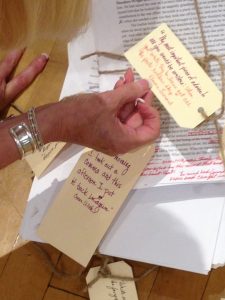 Introduction: What writer hasn’t looked around her office and wondered where all those hard copies of her drafts came from. And then wondered what to do with them. Here is one solution.
Introduction: What writer hasn’t looked around her office and wondered where all those hard copies of her drafts came from. And then wondered what to do with them. Here is one solution.
What I have written exists only if it appears on paper and I am able to hold it in my hands, read it, and make notes on it. Forget the Cloud, and Dropbox, and Mozy. I still fear that Word documents will disappear into the ether and be lost forever despite my multiple backups. So I printed version after version of my novel. When it finally left my hands to be published, I looked around my office and discovered I was surrounded by teetering piles of drafts printed on different colored papers in a variety of fonts. (I had made the happy discovery that changing the font helped make errors more visible.)
I needed to do something about the reams of paper stacked on the floor, on the shelves, and on the chairs before I started the next book, one I hoped would require many fewer ‘very last final versions.’
Salvation arrived by way of a Call for Entries from my local Center for the Arts. Its upcoming juried show had to do with the book—artists’ books, hand-bound books, and altered books. I was inspired. The surrounding stacks of drafts were nothing if not an altered book, particularly if one considered my multi-colored arrows, notes, post-its and revisions.
The original title of the novel had been “Bitter Ashes,” so it seemed most appropriate to burn the drafts, put their ashes and some artfully burned pages in a clear box, and call it, of course, “Bitter Ashes.” However, the noxious odor from burning the first few pages disabused me of that idea.
Then inspiration struck. I had been collecting quotations from writers about revising one’s work.
For example, Elmore Leonard’s advice: “When you write, try to leave out all the parts readers skip.”
And Robert Cormier’s “The beautiful part of writing is that you don’t have to get it right the first time, unlike, say, a brain surgeon.”
I bundled the stacks of paper and tied them with heavy twine. Then I wrote a number of quotations about revising on tags and hung them from the knots. An artist friend knocked my precise stacks around until they looked artfully messy. (I love how artists see things.)
I heaped the stacks on a rolling cart and trundled it off to the art center. My husband warned me that the center volunteers were going to laugh at me. I said that’s okay. Laughter is a response, and in art, provoking almost any response is a good thing.
When I wheeled my masterpiece into the building, political correctness as well as common courtesy flew out the window when the folks accepting the submissions looked at my offering and burst out laughing. So far so good, I thought. I hoped the juror had a sense of humor.
Apparently she did. The piece was accepted, and to my surprise, so was the cart.
After the show closed, my artist friend was horrified that I was going to put it in the recycling bin. He rescued it and the drafts now rest proudly, but messily, on a table and the floor in his living room.
Now if I could just figure out what to do with all those backup disks.




